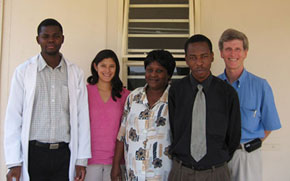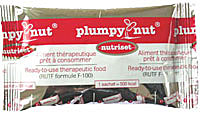UAB Uses Nutrition Science to Fight AIDS in Africa
By Tara Hulen
As medical mysteries go, this one is particularly heartbreaking. Several years ago, UAB clinicians began a large-scale program to bring lifesaving antiretroviral therapy to Zambia. But to their surprise, the same wonder drugs that revolutionized AIDS treatment in the United States produced untoward side effects in Africa.
Scientists at UAB’s Centre for Infectious Disease Research in Zambia (CIDRZ), which administers the program, were perplexed. “In the first 90 days, an unexpectedly large number of patients die after the drugs are started,” says Douglas Heimburger, M.D., a researcher and professor in nutrition sciences and medicine at UAB. “But if they can get through the first 90 days, the patients’ mortality rates are very similar to patients on similar therapies in the United States.”
Dangerous Road to Recovery
This antiretroviral mystery came to light just before Heimburger began a six-month sabbatical in Zambia, and he quickly saw possible nutritional connections to investigate. “The tip-off for me was that one of the risk factors for the early mortality is extreme wasting—that is, being quite underweight,” Heimburger says. This led him to wonder if the deaths could be related to “refeeding syndrome,” a paradoxical effect discovered at the end of World War II when starving prisoners of war died days after they were released and given access to ample food.
 |
Douglas Heimburger, right, pictured with his research team in Zambia.
|
Scientists discovered that reintroducing food to a starving person triggers dangerous metabolic imbalances, says Heimburger—especially a drop in phosphorus levels. The body needs phosphorus to metabolize carbohydrates; when carbohydrates are reintroduced quickly, it depletes the existing supply. And because phosphorus is also a vital part of the recipe used to fuel cells throughout the body, when levels drop below a certain point “you can acutely run out of energy to operate your heart and lungs and you can die from cardiac and pulmonary failure.”
Heimburger wondered if something similar was happening to patients in Zambia. Some AIDS patients report ravenous appetites after they start drug therapy, he says, and the carbohydrate-rich foods that are the staples of their diet might literally feed the problem. This link seemed promising, but Heimburger had to consider other possibilities. “I went over asking the question, ‘Is this the same phenomenon’”—that is, refeeding syndrome—“‘or a variant of it happening when the drugs are introduced?’” he recalls. “‘Or is there something about introducing antiretroviral drugs alone to an AIDS patient that’s similar to reintroducing food to a starved person?’”
While he was in Zambia, Heimburger sought to answer those questions by measuring patients’ blood phosphorus levels several times in the 90-day window after they began antiretroviral treatment. Heimburger found that phosphorus levels dropped in many patients, especially in the first seven days, before generally recovering in the second week. Low levels were also statistically associated with a higher risk of mortality, even though patients with depleted levels received supplements. “We don’t know whether we saved some lives by supplementing patients with low levels, but I would like to think we did because we found quite a few people who needed supplementation,” Heimburger says.
While this initial study was too small to form definitive conclusions, the results were intriguing, says Heimburger. “I would never propose that what I’m onto is ‘it.’ But I think it’s a factor for sure,” he says. “I think we’re onto something.”
Super Peanut Butter to the Rescue?
 Widespread phosphorus testing isn’t practical in Zambia, Heimburger notes, but studies such as these suggest that nutrition plays a role in the early mortality mystery. He and UAB faculty colleagues based at CIDRZ would now like to test methods of feeding patients—treating their hunger, in other words—without increasing the risk of low phosphorus levels.
Widespread phosphorus testing isn’t practical in Zambia, Heimburger notes, but studies such as these suggest that nutrition plays a role in the early mortality mystery. He and UAB faculty colleagues based at CIDRZ would now like to test methods of feeding patients—treating their hunger, in other words—without increasing the risk of low phosphorus levels.
Heimburger returned to Zambia recently to discuss the refeeding problem with CIDRZ colleagues. The researchers think they may have a solution—a kind of super peanut butter used to refeed people in famine areas that could also be given to underweight AIDS patients as they begin antiretroviral therapy. This “Ready to Use Therapeutic Formula,” or RUTF, should be well tolerated because it is rich in protein and fat with very few carbohydrates, says Heimburger.
One brand, called Plumpy’nut, has been widely covered in the press and scientifically documented as effective, Heimburger adds. “This stuff really works and it’s the best way to refeed children in famine situations. We want to look at the effects of providing RUTF along with drugs to see if we can’t double the benefit without risking harm in the short term.”
More Information